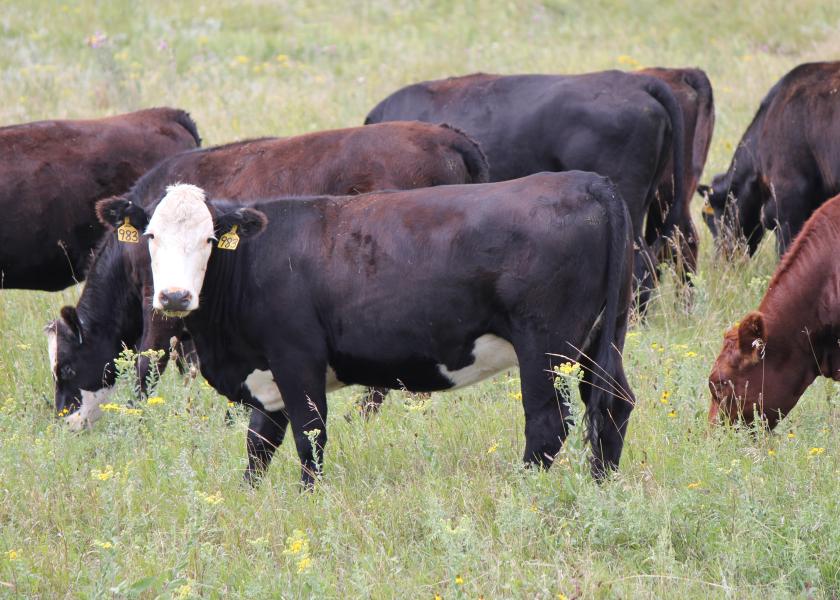Consider Supplementation Strategies to Stretch Limited Pasture Resources

Drought conditions in portions of North Dakota are forcing some farmers and ranchers to consider their options, according to North Dakota State University Extension specialists. Currently 30% of the state is experiencing some level of drought with several counties in northern North Dakota experiencing severe drought (D2). Producers in these areas are experiencing below normal forage production and poor pasture conditions.
“Drought-affected pastures and native ranges generally do not produce adequate forage to maintain normal stocking rates,” says Miranda Meehan, NDSU Extension livestock environmental stewardship specialist. “Stocking rate can be adjusted by reducing the number of animals and/or the length the grazing period. Farmers and ranchers must make the decision to sell cattle, relocate cattle to a drylot, or provide supplemental feed to offset nutrient deficiencies in the forage or replace a portion of pasture or range intake.”
Reductions in stocking rate will benefit range plants by reducing stress and providing more forage for the remaining cattle, Meehan adds. When stocking rates are reduced, only small effects on weaning weight may be noted. If stocking rates are not reduced, supplemental feeding is necessary to maintain herd productivity and alleviate grazing pressure. Additionally, producers will likely see a decrease in forage production on pastures that are overstocked the subsequent grazing season.
Supplementing on pasture or range can help stretch available forage and allow farmers and ranchers to maintain “normal” stocking rates this fall. However, caution must be taken when considering supplementation strategies when the goal is to replace pasture or range intake.
“The main objective of supplementation programs is to meet nutrient requirements as efficiently and economically as possible,” says Zac Carlson, NDSU Extension beef cattle specialist. “The thought of replacing pasture or range with feed for cattle grazing would be to substitute daily pasture intake with an economical feed that doesn’t negatively impact forage digestion. To do that, factors that should be considered when making decisions about supplements include forage supply, protein content, body condition, and cost and availability of supplements.”
“If forage production is limited, farmers and ranchers may wish to replace a portion of pasture intake with supplemental feed,” says Karl Hoppe, NDSU Extension livestock systems specialist based at NDSU’s Carrington Research Extension Center. “Feeding harvested forages such as alfalfa or annual forages on pasture is one option; however, forage supplies are already short in many situations.”
It is also challenging to get cattle to consume harvested forage while on pasture,” Hoppe notes. Farmers and ranchers should provide at least 0.5% of bodyweight of alfalfa hay daily to replace pasture intake with alfalfa hay. It is recommended to supplement harvested forages on tame pasture over native pasture to reduce the introduction of undesirable plant species on native range.
Grain-based supplements can reduce forage intake by providing a substitution effect. However, cereal grains contain starch and sugars, which will lower ruminal pH and reduce forage digestibility, especially at higher feeding levels. This results in less energy from available pasture or range to the animal. Therefore, cereal grain supplements should be limited to 0.25% of bodyweight to minimize the negative effects on forage utilization.
For some grains, processing may be necessary for optimum use by cattle. Corn and oats can be fed whole but may be better utilized if coarsely rolled before feeding. Barley and wheat should be coarsely rolled.
Unlike protein supplements, energy supplements should be delivered daily for optimal performance to avoid excess energy intake and maintain optimum conditions in the rumen.
Fibrous by-product feeds, such as soyhulls, wheat middlings, corn gluten feed, distillers grains, beet pulp and brewers grains, contain low levels of starch and sugars, but high total digestible nutrient values have less negative impacts on forage intake and digestibility. However, fibrous by-product feeds should be supplemented at levels greater than 0.6% of bodyweight daily to replace pasture or range intake.
Farmers and ranchers may consider feeding cattle in a drylot if pasture conditions are extremely poor. This may be more cost-effective than supplementation if large amounts of supplement must be transported and fed to cattle daily. In addition, it may allow pastures a much-needed rest period to begin recovering from the drought.
For additional information on supplementation strategies, view the NDSU Extension publications “Drylot Beef Cow-Calf Production” at ndsu.ag/drylot and “Alternative Feeds for Ruminants” at ndsu.ag/alternativefeeds.







